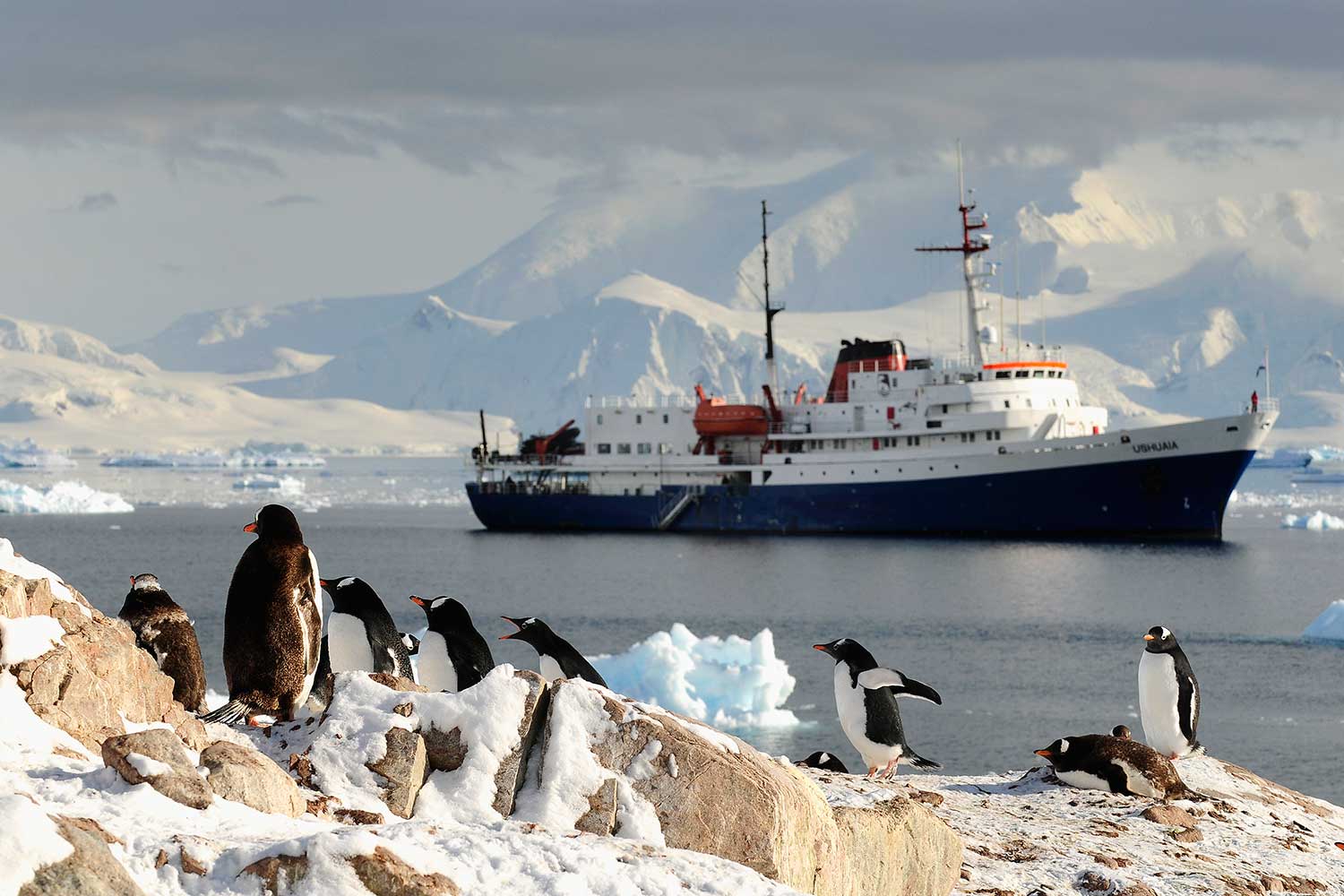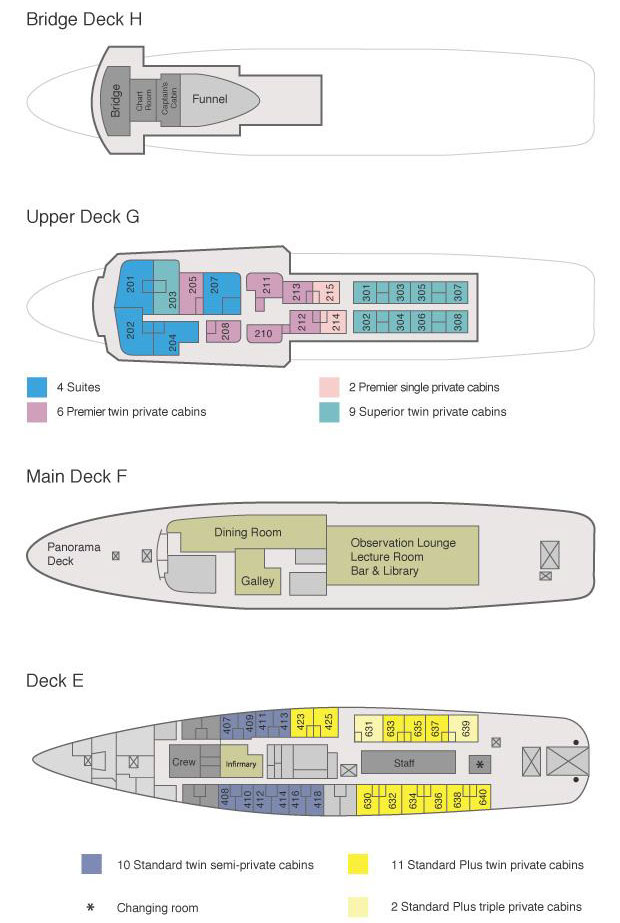Classic South Georgia: M/V Ushuaia
South Georgia and Antarctic Peninsula
This expedition cruise to the Falkland Islands, South Georgia and Antarctica is perfectly timed to take best advantage of the spectacular scenery and wildlife breeding activity during the exciting early period of the Antarctic summer. Travelling on such a small ship offers the immense advantage of allowing everyone ashore at the same time for a better experience and longer landings
- Follow in the footsteps of Shackleton to South Georgia and toast this explorer at his graveside.
- Early season voyage with maximum wildlife!
- Enthusiastic and expert team of lecturers.
- Small expedition vessel with just 90 passengers for more landing time
- Incredible wildlife including more than 30 species of breeding birds, including six species of Penguin.
- Explore the quaint, British town of Port Stanley in the Falkland Islands.

Stewart's Take
A thrilling early-season Antarctic expedition with six full days on South Georgia. Witness the amazing beaches filled with thousands of king penguins and huge elephant seals - a wildlife extravaganza!
Overview
This expedition cruise to the Falkland Islands, South Georgia and Antarctica is perfectly timed to take best advantage of the spectacular scenery and wildlife breeding activity during the exciting early period of the Antarctic summer. Travelling on such a small ship offers the immense advantage of allowing everyone ashore at the same time for a better experience and longer landings.Scrolling is disabled on map, please click to enable.
Expedition Vessel: M/V Ushuaia

Originally built for the United States agency NOAA (National Oceanic & Atmospheric Administration), the USHUAIA has been refurbished to accommodate a maximum of 90 passengers in 46 comfortable cabins and suites. The ice-strengthened polar vessel USHUAIA is very well appointed and provides ample deck space and an open bridge policy. The full complement of inflatable landing craft ensures superb landings and wildlife viewing opportunities on the otherwise inaccessible coastline. All cabins include ample storage space. Public areas feature a large dining room (one sitting), an observation lounge and bar, a conference room with modern multimedia equipment, a well-stocked library, a changing room and a small infirmary. The expert captain, officers and crew are highly experienced in Antarctic navigation and have a great love of nature. A specialist team of international expedition leaders and lecturers are all extremely knowledgeable, enthusiastic, helpful and dedicated to the protection of the environment. Chefs prepare excellent cuisine including many local specialties and the bar is well-stocked with carefully selected wines and spirits.

- Voyage aboard the M/V Ushuaia as indicated in the itinerary.
- All meals throughout the voyage aboard the M/V Ushuaia.
- All shore excursions and activities throughout the voyage by zodiac.
- Program of lectures by noted naturalists and leadership by experienced expedition staff.
- All miscellaneous service taxes and port charges throughout the program.
- Comprehensive pre-departure material.
- Detailed post-expedition log.
- Any airfare other than that mentioned as included
- Pre- and post land arrangements
- Transfers to / from the vessel
- Passport and visa expenses
- Government arrival and departure taxes
- Meals ashore
- Baggage, cancellation and personal insurance (strongly recommended)
- Excess baggage charges and all items of a personal nature such as bar and beverage charges and telecommunication charges
- The customary gratuity at the end of the voyages (guidelines will be provided).

Tour Dossier
Classic South Georgia: M/V Ushuaia

A 22 day expedition to the remarkable sub-Antarctic paradise of South Georgia and the Antarctic Peninsula aboard the M/V Ushuaia
File Creation date: 2024-04-24 - for updated information and dates and prices see the following page:
http://expeditionsonline.com/tour/classic-south-georgia-mv-ushuaia_27

Classic South Georgia: M/V Ushuaia
Duration: 22 days
Location: South Georgia and Antarctic Peninsula
Available: October-November
Start: Ushuaia, Argentina
Finish: Ushuaia, Argentina

Highlights
- Follow in the footsteps of Shackleton to South Georgia and toast this explorer at his graveside.
- Early season voyage with maximum wildlife!
- Enthusiastic and expert team of lecturers.
- Small expedition vessel with just 90 passengers for more landing time
- Incredible wildlife including more than 30 species of breeding birds, including six species of Penguin.
- Explore the quaint, British town of Port Stanley in the Falkland Islands.

Itinerary
This expedition cruise to the Falkland Islands, South Georgia and Antarctica is perfectly timed to take best advantage of the spectacular scenery and wildlife breeding activity during the exciting early period of the Antarctic summer. Travelling on such a small ship offers the immense advantage of allowing everyone ashore at the same time for a better experience and longer landings





Ship Information
Expedition Vessel: M/V Ushuaia

Originally built for the United States agency NOAA (National Oceanic & Atmospheric Administration), the USHUAIA has been refurbished to accommodate a maximum of 90 passengers in 46 comfortable cabins and suites. The ice-strengthened polar vessel USHUAIA is very well appointed and provides ample deck space and an open bridge policy. The full complement of inflatable landing craft ensures superb landings and wildlife viewing opportunities on the otherwise inaccessible coastline. All cabins include ample storage space. Public areas feature a large dining room (one sitting), an observation lounge and bar, a conference room with modern multimedia equipment, a well-stocked library, a changing room and a small infirmary. The expert captain, officers and crew are highly experienced in Antarctic navigation and have a great love of nature. A specialist team of international expedition leaders and lecturers are all extremely knowledgeable, enthusiastic, helpful and dedicated to the protection of the environment. Chefs prepare excellent cuisine including many local specialties and the bar is well-stocked with carefully selected wines and spirits.

Classic South Georgia: M/V Ushuaia
For the latest, up-to-date departure dates and prices please refer to the tour page:
http://expeditionsonline.com/tour/classic-south-georgia-mv-ushuaia_27
Included
- Voyage aboard the M/V Ushuaia as indicated in the itinerary.
- All meals throughout the voyage aboard the M/V Ushuaia.
- All shore excursions and activities throughout the voyage by zodiac.
- Program of lectures by noted naturalists and leadership by experienced expedition staff.
- All miscellaneous service taxes and port charges throughout the program.
- Comprehensive pre-departure material.
- Detailed post-expedition log.
Excluded
- Any airfare other than that mentioned as included
- Pre- and post land arrangements
- Transfers to / from the vessel
- Passport and visa expenses
- Government arrival and departure taxes
- Meals ashore
- Baggage, cancellation and personal insurance (strongly recommended)
- Excess baggage charges and all items of a personal nature such as bar and beverage charges and telecommunication charges
- The customary gratuity at the end of the voyages (guidelines will be provided).

General Terms and Conditions
Expeditions Online Newsletter
Sign up to be an Expeditions Online insider and receive info on exclusive deals, discounts and more!